WHS & Risk Management Report - BSBRSK501 & BSBWHS605, Sem 3, 2018
VerifiedAdded on 2023/06/10
|19
|2596
|362
Report
AI Summary
This report provides a comprehensive analysis of work health and safety (WHS) and risk management within an organizational context, aligning with the requirements of the WHS Act and Regulations in Australia. It establishes the risk context by outlining a risk management plan, defining the scope of the risk management process, identifying stakeholders and communication methods, and conducting PESTLE and SWOT analyses. The report analyzes risks by identifying potential hazards and their likelihood and consequences, and proposes risk treatment strategies with an action plan for WHS implementation. It emphasizes the importance of risk documentation and the use of legislative frameworks like the Privacy Law 1988, and concludes with a list of appropriate insurances for the hospitality industry, highlighting the necessity of analyzing, monitoring, and evaluating the risk management process to ensure effective control implementation and continuous improvement.
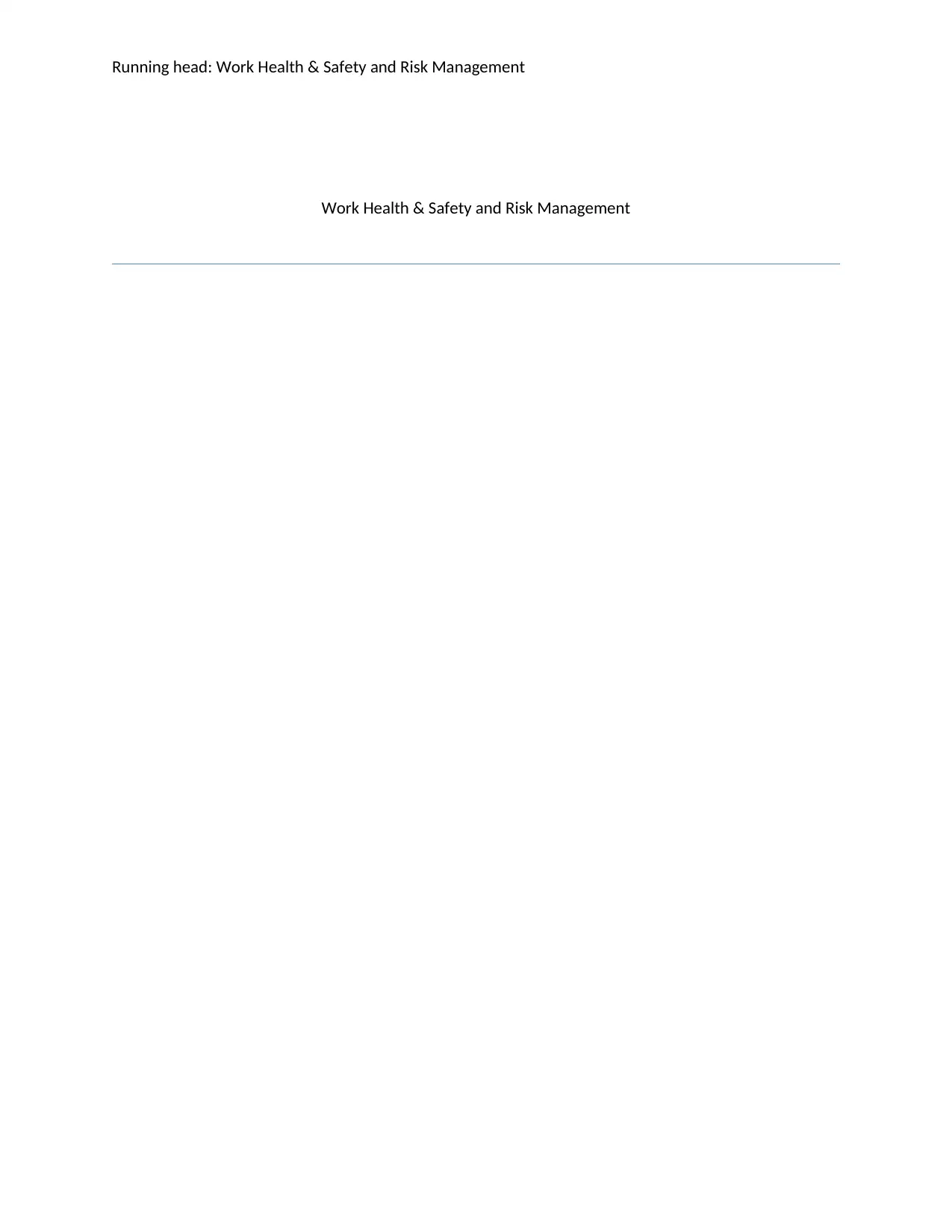
Running head: Work Health & Safety and Risk Management
Work Health & Safety and Risk Management
Work Health & Safety and Risk Management
Paraphrase This Document
Need a fresh take? Get an instant paraphrase of this document with our AI Paraphraser
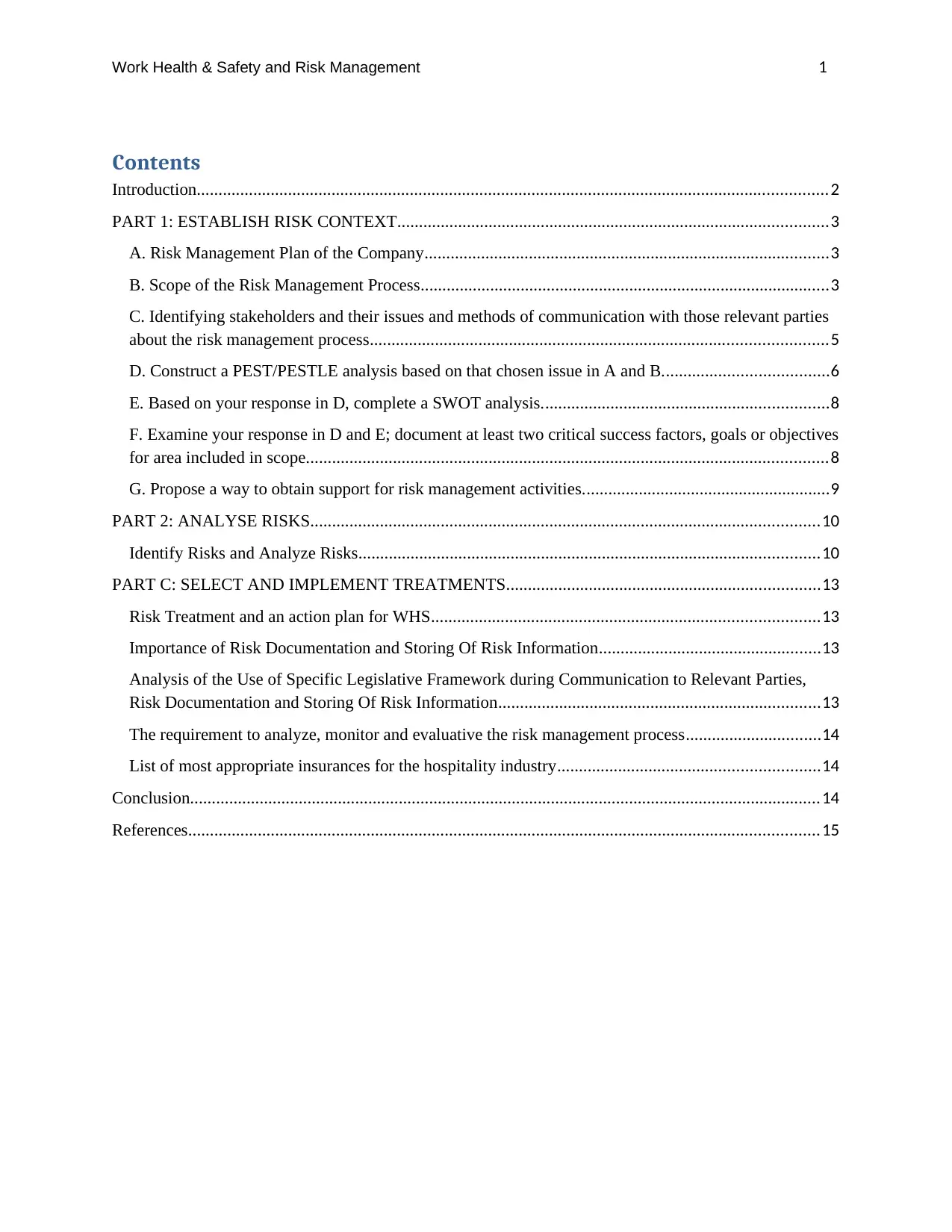
Work Health & Safety and Risk Management 1
Contents
Introduction.................................................................................................................................................2
PART 1: ESTABLISH RISK CONTEXT...................................................................................................3
A. Risk Management Plan of the Company.............................................................................................3
B. Scope of the Risk Management Process..............................................................................................3
C. Identifying stakeholders and their issues and methods of communication with those relevant parties
about the risk management process.........................................................................................................5
D. Construct a PEST/PESTLE analysis based on that chosen issue in A and B......................................6
E. Based on your response in D, complete a SWOT analysis..................................................................8
F. Examine your response in D and E; document at least two critical success factors, goals or objectives
for area included in scope........................................................................................................................8
G. Propose a way to obtain support for risk management activities.........................................................9
PART 2: ANALYSE RISKS.....................................................................................................................10
Identify Risks and Analyze Risks..........................................................................................................10
PART C: SELECT AND IMPLEMENT TREATMENTS........................................................................13
Risk Treatment and an action plan for WHS.........................................................................................13
Importance of Risk Documentation and Storing Of Risk Information...................................................13
Analysis of the Use of Specific Legislative Framework during Communication to Relevant Parties,
Risk Documentation and Storing Of Risk Information..........................................................................13
The requirement to analyze, monitor and evaluative the risk management process...............................14
List of most appropriate insurances for the hospitality industry............................................................14
Conclusion.................................................................................................................................................14
References.................................................................................................................................................15
Contents
Introduction.................................................................................................................................................2
PART 1: ESTABLISH RISK CONTEXT...................................................................................................3
A. Risk Management Plan of the Company.............................................................................................3
B. Scope of the Risk Management Process..............................................................................................3
C. Identifying stakeholders and their issues and methods of communication with those relevant parties
about the risk management process.........................................................................................................5
D. Construct a PEST/PESTLE analysis based on that chosen issue in A and B......................................6
E. Based on your response in D, complete a SWOT analysis..................................................................8
F. Examine your response in D and E; document at least two critical success factors, goals or objectives
for area included in scope........................................................................................................................8
G. Propose a way to obtain support for risk management activities.........................................................9
PART 2: ANALYSE RISKS.....................................................................................................................10
Identify Risks and Analyze Risks..........................................................................................................10
PART C: SELECT AND IMPLEMENT TREATMENTS........................................................................13
Risk Treatment and an action plan for WHS.........................................................................................13
Importance of Risk Documentation and Storing Of Risk Information...................................................13
Analysis of the Use of Specific Legislative Framework during Communication to Relevant Parties,
Risk Documentation and Storing Of Risk Information..........................................................................13
The requirement to analyze, monitor and evaluative the risk management process...............................14
List of most appropriate insurances for the hospitality industry............................................................14
Conclusion.................................................................................................................................................14
References.................................................................................................................................................15
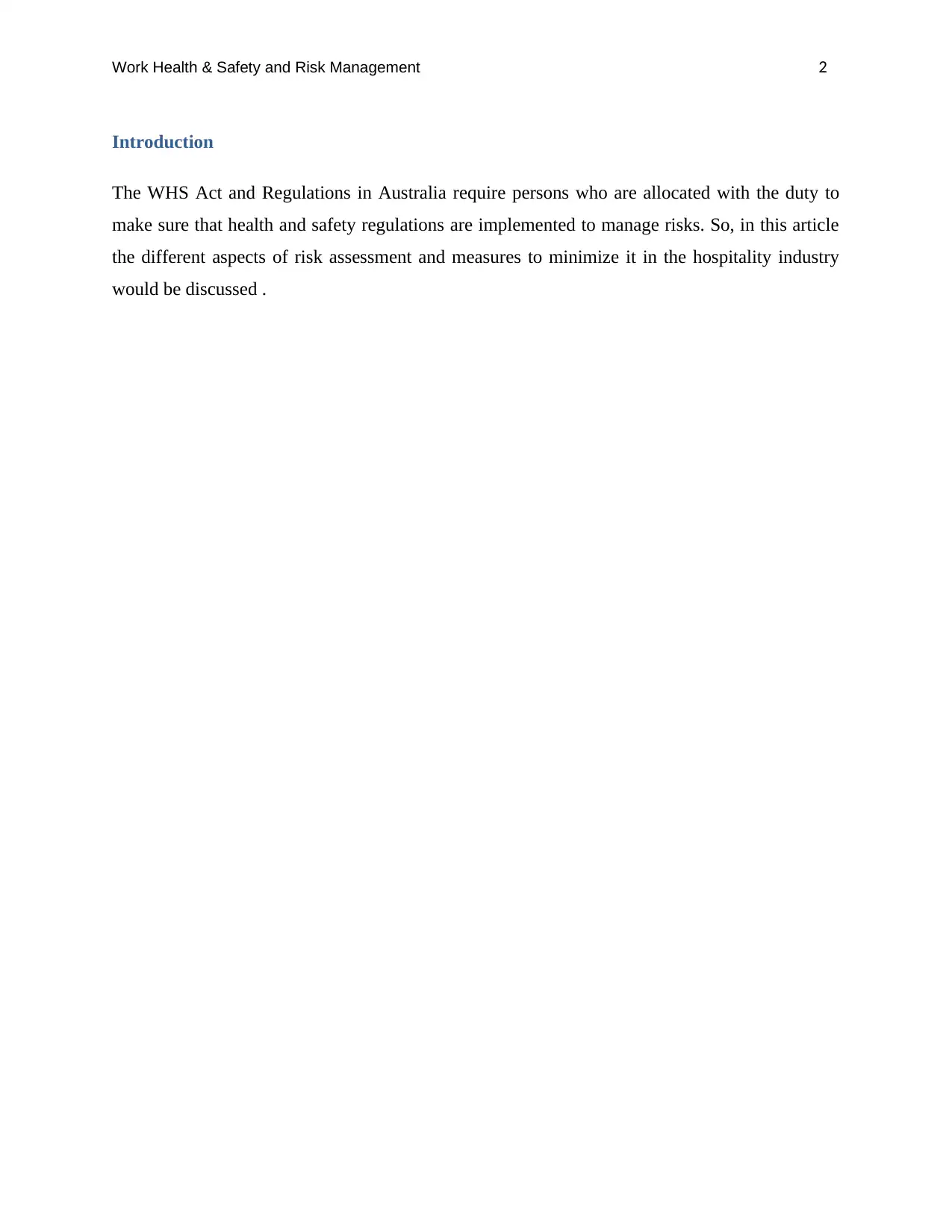
Work Health & Safety and Risk Management 2
Introduction
The WHS Act and Regulations in Australia require persons who are allocated with the duty to
make sure that health and safety regulations are implemented to manage risks. So, in this article
the different aspects of risk assessment and measures to minimize it in the hospitality industry
would be discussed .
Introduction
The WHS Act and Regulations in Australia require persons who are allocated with the duty to
make sure that health and safety regulations are implemented to manage risks. So, in this article
the different aspects of risk assessment and measures to minimize it in the hospitality industry
would be discussed .
⊘ This is a preview!⊘
Do you want full access?
Subscribe today to unlock all pages.

Trusted by 1+ million students worldwide
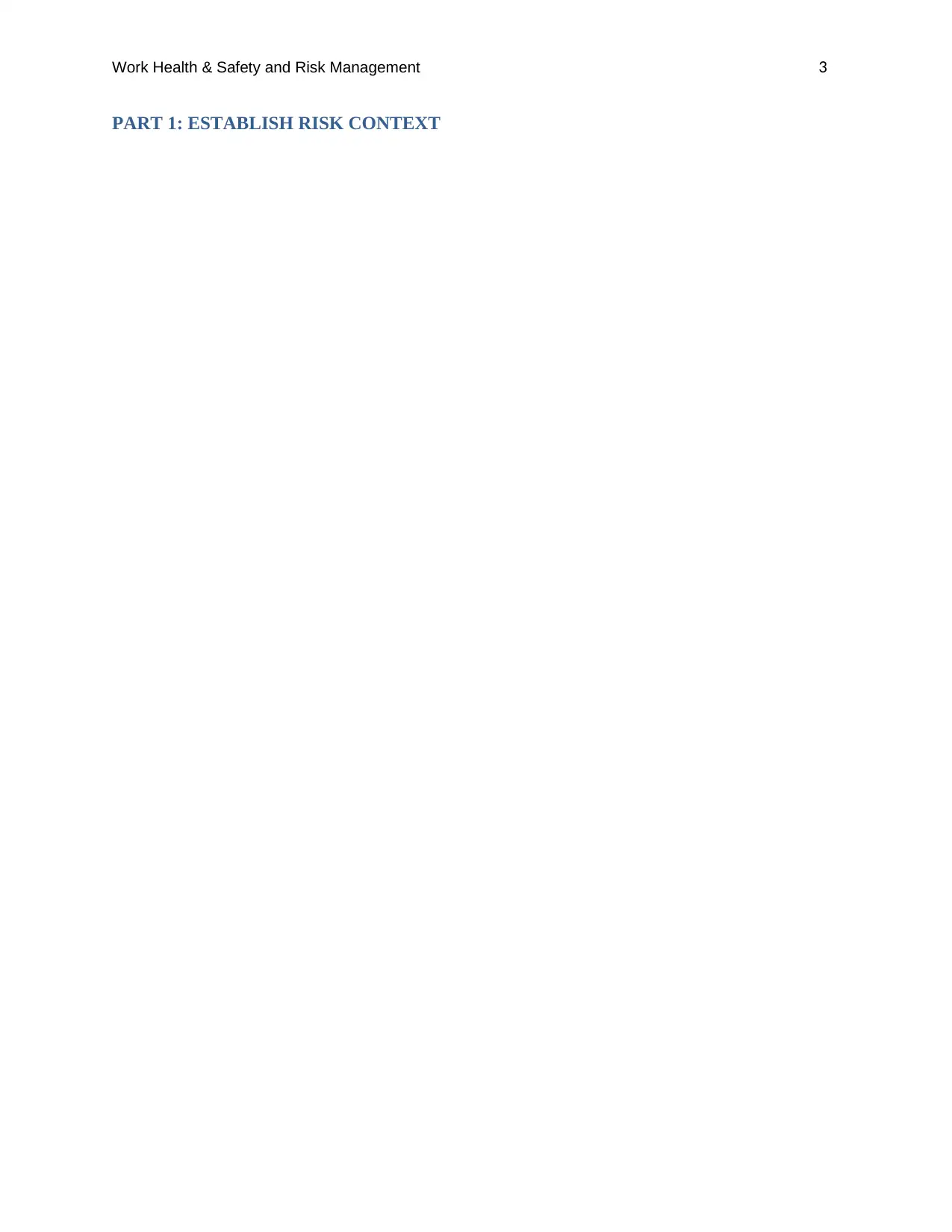
Work Health & Safety and Risk Management 3
PART 1: ESTABLISH RISK CONTEXT
PART 1: ESTABLISH RISK CONTEXT
Paraphrase This Document
Need a fresh take? Get an instant paraphrase of this document with our AI Paraphraser
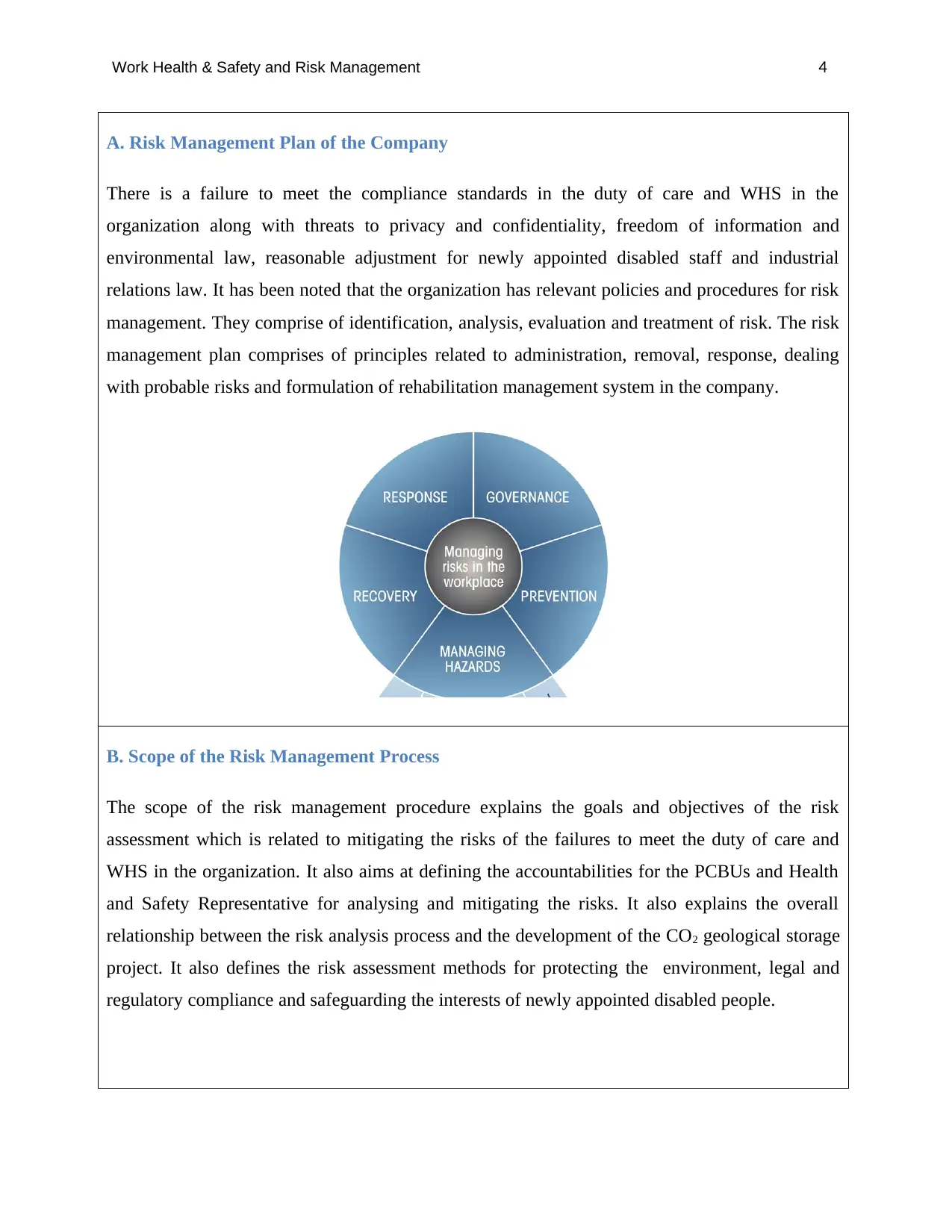
Work Health & Safety and Risk Management 4
A. Risk Management Plan of the Company
There is a failure to meet the compliance standards in the duty of care and WHS in the
organization along with threats to privacy and confidentiality, freedom of information and
environmental law, reasonable adjustment for newly appointed disabled staff and industrial
relations law. It has been noted that the organization has relevant policies and procedures for risk
management. They comprise of identification, analysis, evaluation and treatment of risk. The risk
management plan comprises of principles related to administration, removal, response, dealing
with probable risks and formulation of rehabilitation management system in the company.
B. Scope of the Risk Management Process
The scope of the risk management procedure explains the goals and objectives of the risk
assessment which is related to mitigating the risks of the failures to meet the duty of care and
WHS in the organization. It also aims at defining the accountabilities for the PCBUs and Health
and Safety Representative for analysing and mitigating the risks. It also explains the overall
relationship between the risk analysis process and the development of the CO2 geological storage
project. It also defines the risk assessment methods for protecting the environment, legal and
regulatory compliance and safeguarding the interests of newly appointed disabled people.
A. Risk Management Plan of the Company
There is a failure to meet the compliance standards in the duty of care and WHS in the
organization along with threats to privacy and confidentiality, freedom of information and
environmental law, reasonable adjustment for newly appointed disabled staff and industrial
relations law. It has been noted that the organization has relevant policies and procedures for risk
management. They comprise of identification, analysis, evaluation and treatment of risk. The risk
management plan comprises of principles related to administration, removal, response, dealing
with probable risks and formulation of rehabilitation management system in the company.
B. Scope of the Risk Management Process
The scope of the risk management procedure explains the goals and objectives of the risk
assessment which is related to mitigating the risks of the failures to meet the duty of care and
WHS in the organization. It also aims at defining the accountabilities for the PCBUs and Health
and Safety Representative for analysing and mitigating the risks. It also explains the overall
relationship between the risk analysis process and the development of the CO2 geological storage
project. It also defines the risk assessment methods for protecting the environment, legal and
regulatory compliance and safeguarding the interests of newly appointed disabled people.
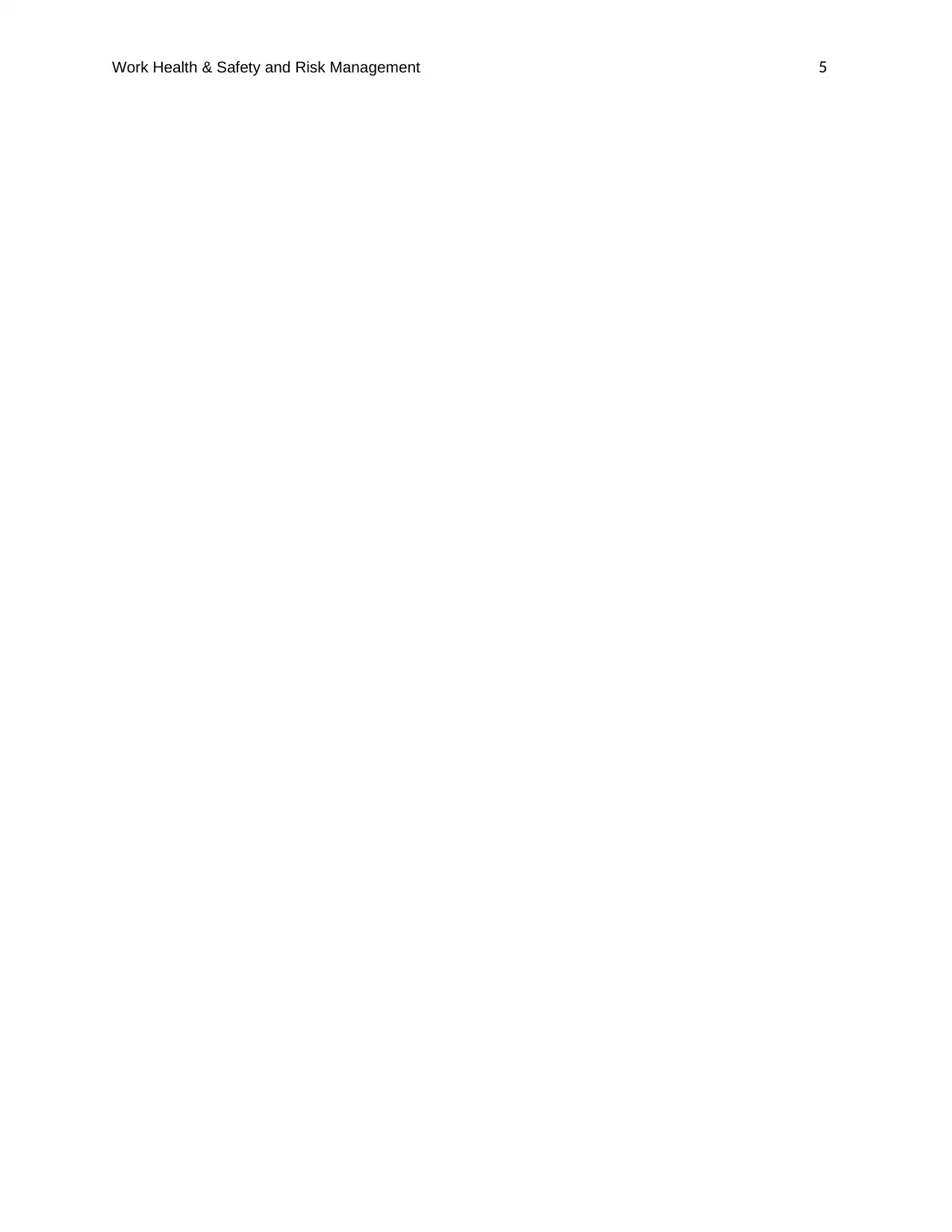
Work Health & Safety and Risk Management 5
⊘ This is a preview!⊘
Do you want full access?
Subscribe today to unlock all pages.

Trusted by 1+ million students worldwide
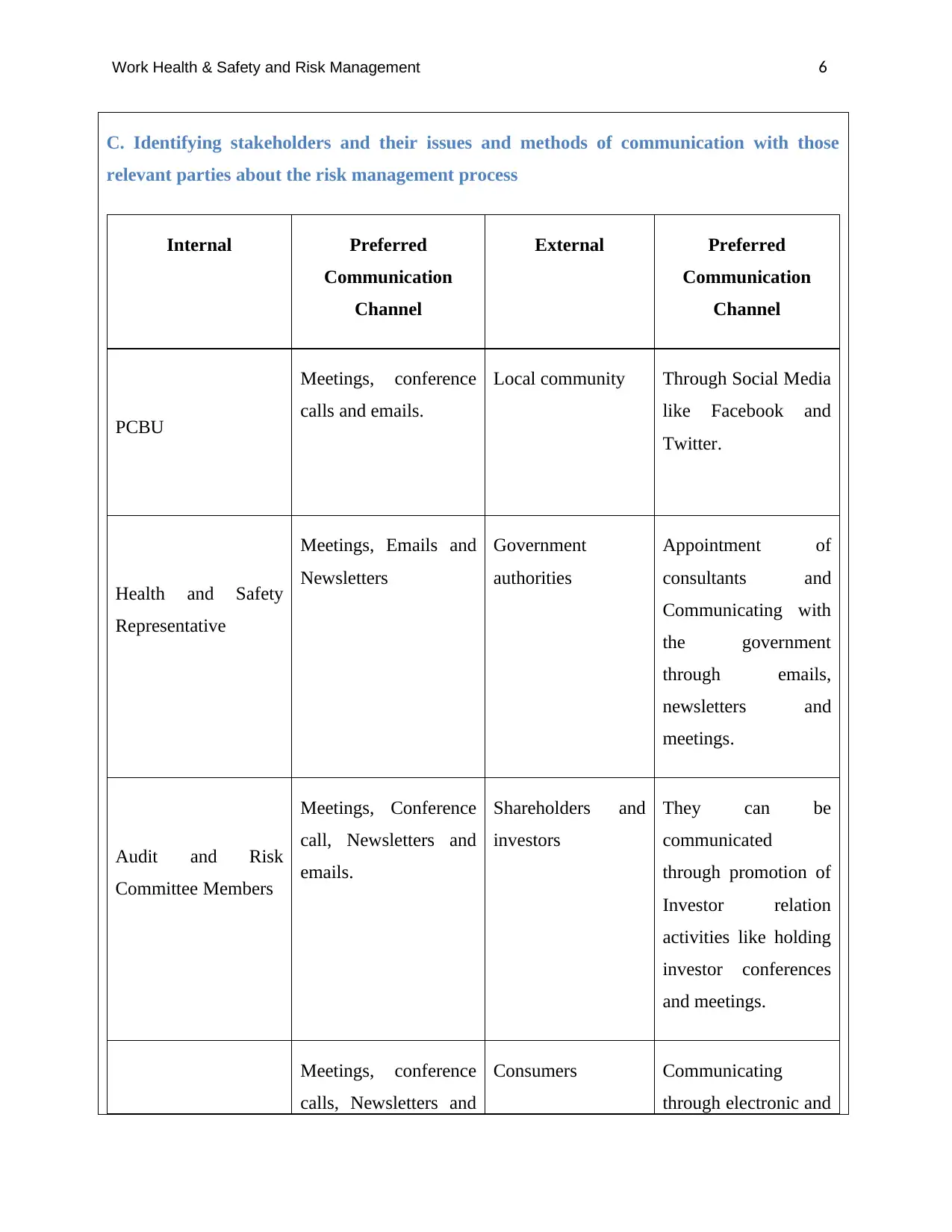
Work Health & Safety and Risk Management 6
C. Identifying stakeholders and their issues and methods of communication with those
relevant parties about the risk management process
Internal Preferred
Communication
Channel
External Preferred
Communication
Channel
PCBU
Meetings, conference
calls and emails.
Local community Through Social Media
like Facebook and
Twitter.
Health and Safety
Representative
Meetings, Emails and
Newsletters
Government
authorities
Appointment of
consultants and
Communicating with
the government
through emails,
newsletters and
meetings.
Audit and Risk
Committee Members
Meetings, Conference
call, Newsletters and
emails.
Shareholders and
investors
They can be
communicated
through promotion of
Investor relation
activities like holding
investor conferences
and meetings.
Meetings, conference
calls, Newsletters and
Consumers Communicating
through electronic and
C. Identifying stakeholders and their issues and methods of communication with those
relevant parties about the risk management process
Internal Preferred
Communication
Channel
External Preferred
Communication
Channel
PCBU
Meetings, conference
calls and emails.
Local community Through Social Media
like Facebook and
Twitter.
Health and Safety
Representative
Meetings, Emails and
Newsletters
Government
authorities
Appointment of
consultants and
Communicating with
the government
through emails,
newsletters and
meetings.
Audit and Risk
Committee Members
Meetings, Conference
call, Newsletters and
emails.
Shareholders and
investors
They can be
communicated
through promotion of
Investor relation
activities like holding
investor conferences
and meetings.
Meetings, conference
calls, Newsletters and
Consumers Communicating
through electronic and
Paraphrase This Document
Need a fresh take? Get an instant paraphrase of this document with our AI Paraphraser
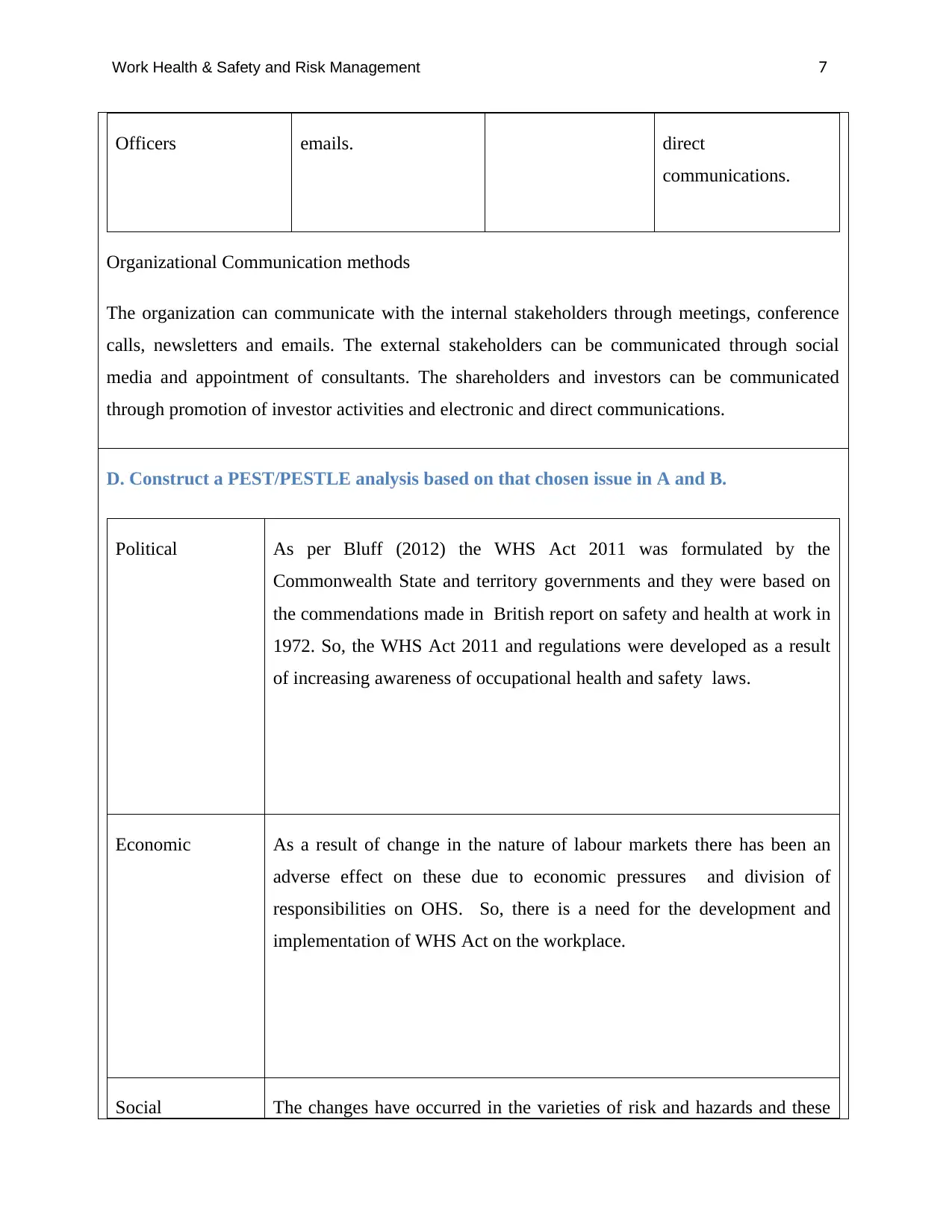
Work Health & Safety and Risk Management 7
Officers emails. direct
communications.
Organizational Communication methods
The organization can communicate with the internal stakeholders through meetings, conference
calls, newsletters and emails. The external stakeholders can be communicated through social
media and appointment of consultants. The shareholders and investors can be communicated
through promotion of investor activities and electronic and direct communications.
D. Construct a PEST/PESTLE analysis based on that chosen issue in A and B.
Political As per Bluff (2012) the WHS Act 2011 was formulated by the
Commonwealth State and territory governments and they were based on
the commendations made in British report on safety and health at work in
1972. So, the WHS Act 2011 and regulations were developed as a result
of increasing awareness of occupational health and safety laws.
Economic As a result of change in the nature of labour markets there has been an
adverse effect on these due to economic pressures and division of
responsibilities on OHS. So, there is a need for the development and
implementation of WHS Act on the workplace.
Social The changes have occurred in the varieties of risk and hazards and these
Officers emails. direct
communications.
Organizational Communication methods
The organization can communicate with the internal stakeholders through meetings, conference
calls, newsletters and emails. The external stakeholders can be communicated through social
media and appointment of consultants. The shareholders and investors can be communicated
through promotion of investor activities and electronic and direct communications.
D. Construct a PEST/PESTLE analysis based on that chosen issue in A and B.
Political As per Bluff (2012) the WHS Act 2011 was formulated by the
Commonwealth State and territory governments and they were based on
the commendations made in British report on safety and health at work in
1972. So, the WHS Act 2011 and regulations were developed as a result
of increasing awareness of occupational health and safety laws.
Economic As a result of change in the nature of labour markets there has been an
adverse effect on these due to economic pressures and division of
responsibilities on OHS. So, there is a need for the development and
implementation of WHS Act on the workplace.
Social The changes have occurred in the varieties of risk and hazards and these
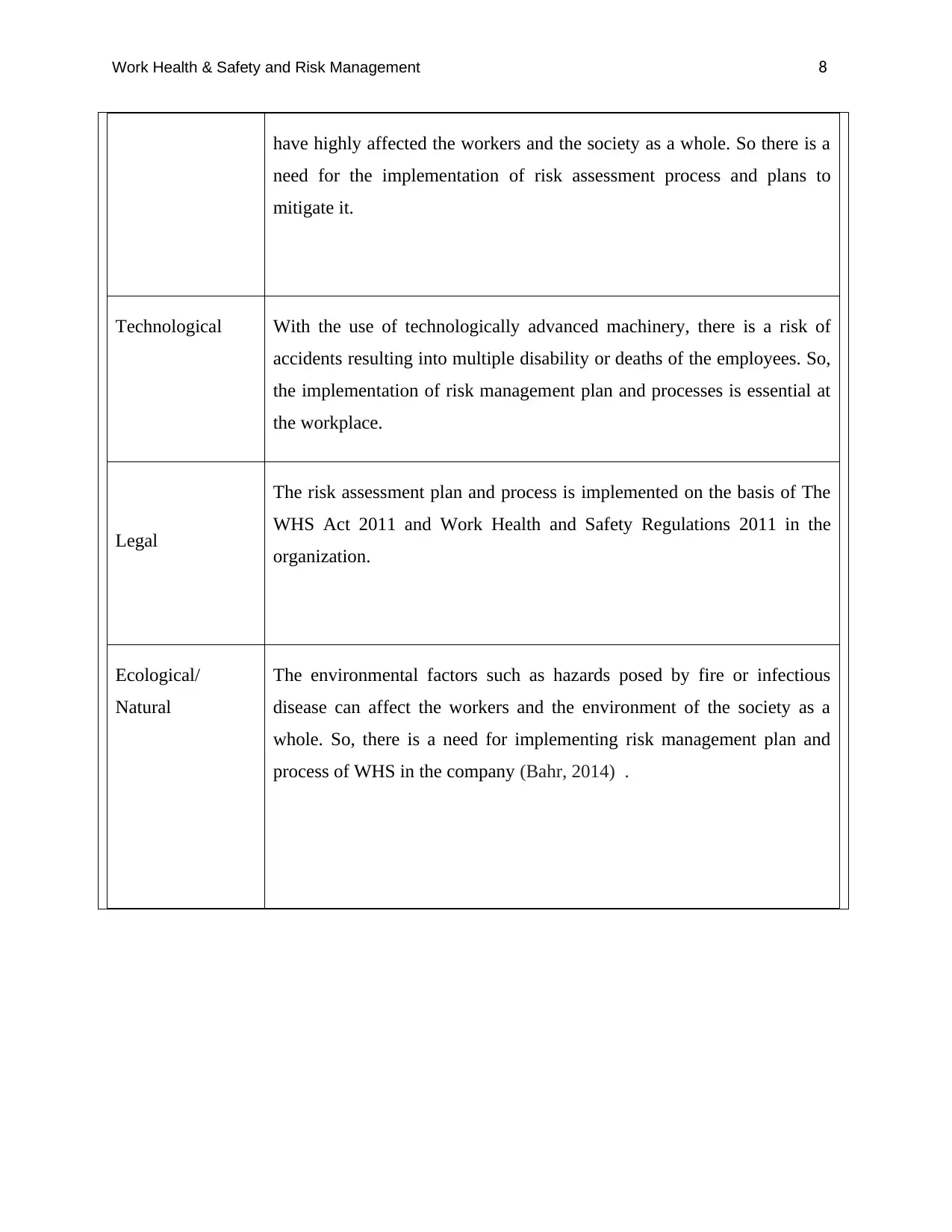
Work Health & Safety and Risk Management 8
have highly affected the workers and the society as a whole. So there is a
need for the implementation of risk assessment process and plans to
mitigate it.
Technological With the use of technologically advanced machinery, there is a risk of
accidents resulting into multiple disability or deaths of the employees. So,
the implementation of risk management plan and processes is essential at
the workplace.
Legal
The risk assessment plan and process is implemented on the basis of The
WHS Act 2011 and Work Health and Safety Regulations 2011 in the
organization.
Ecological/
Natural
The environmental factors such as hazards posed by fire or infectious
disease can affect the workers and the environment of the society as a
whole. So, there is a need for implementing risk management plan and
process of WHS in the company (Bahr, 2014) .
have highly affected the workers and the society as a whole. So there is a
need for the implementation of risk assessment process and plans to
mitigate it.
Technological With the use of technologically advanced machinery, there is a risk of
accidents resulting into multiple disability or deaths of the employees. So,
the implementation of risk management plan and processes is essential at
the workplace.
Legal
The risk assessment plan and process is implemented on the basis of The
WHS Act 2011 and Work Health and Safety Regulations 2011 in the
organization.
Ecological/
Natural
The environmental factors such as hazards posed by fire or infectious
disease can affect the workers and the environment of the society as a
whole. So, there is a need for implementing risk management plan and
process of WHS in the company (Bahr, 2014) .
⊘ This is a preview!⊘
Do you want full access?
Subscribe today to unlock all pages.

Trusted by 1+ million students worldwide
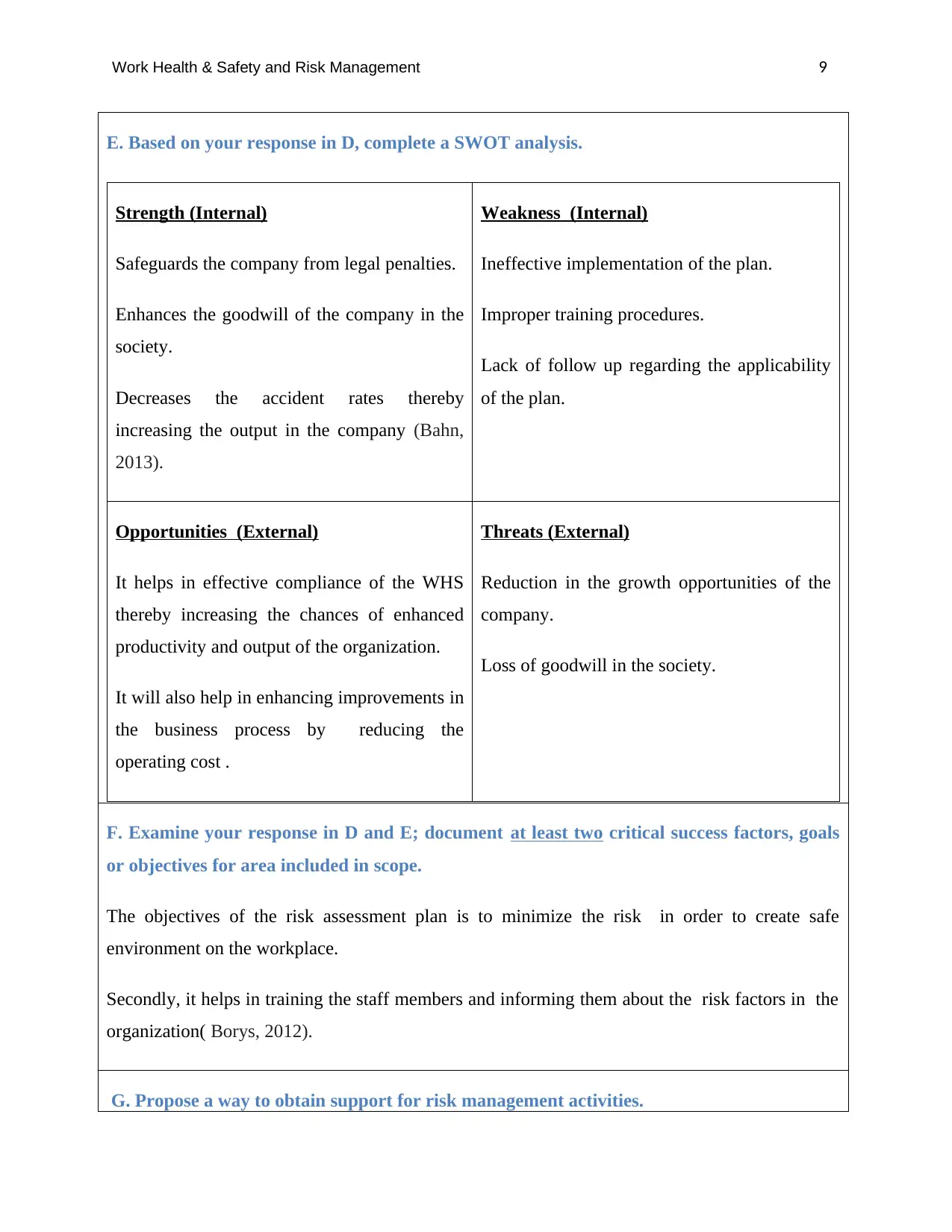
Work Health & Safety and Risk Management 9
E. Based on your response in D, complete a SWOT analysis.
Strength (Internal)
Safeguards the company from legal penalties.
Enhances the goodwill of the company in the
society.
Decreases the accident rates thereby
increasing the output in the company (Bahn,
2013).
Weakness (Internal)
Ineffective implementation of the plan.
Improper training procedures.
Lack of follow up regarding the applicability
of the plan.
Opportunities (External)
It helps in effective compliance of the WHS
thereby increasing the chances of enhanced
productivity and output of the organization.
It will also help in enhancing improvements in
the business process by reducing the
operating cost .
Threats (External)
Reduction in the growth opportunities of the
company.
Loss of goodwill in the society.
F. Examine your response in D and E; document at least two critical success factors, goals
or objectives for area included in scope.
The objectives of the risk assessment plan is to minimize the risk in order to create safe
environment on the workplace.
Secondly, it helps in training the staff members and informing them about the risk factors in the
organization( Borys, 2012).
G. Propose a way to obtain support for risk management activities.
E. Based on your response in D, complete a SWOT analysis.
Strength (Internal)
Safeguards the company from legal penalties.
Enhances the goodwill of the company in the
society.
Decreases the accident rates thereby
increasing the output in the company (Bahn,
2013).
Weakness (Internal)
Ineffective implementation of the plan.
Improper training procedures.
Lack of follow up regarding the applicability
of the plan.
Opportunities (External)
It helps in effective compliance of the WHS
thereby increasing the chances of enhanced
productivity and output of the organization.
It will also help in enhancing improvements in
the business process by reducing the
operating cost .
Threats (External)
Reduction in the growth opportunities of the
company.
Loss of goodwill in the society.
F. Examine your response in D and E; document at least two critical success factors, goals
or objectives for area included in scope.
The objectives of the risk assessment plan is to minimize the risk in order to create safe
environment on the workplace.
Secondly, it helps in training the staff members and informing them about the risk factors in the
organization( Borys, 2012).
G. Propose a way to obtain support for risk management activities.
Paraphrase This Document
Need a fresh take? Get an instant paraphrase of this document with our AI Paraphraser
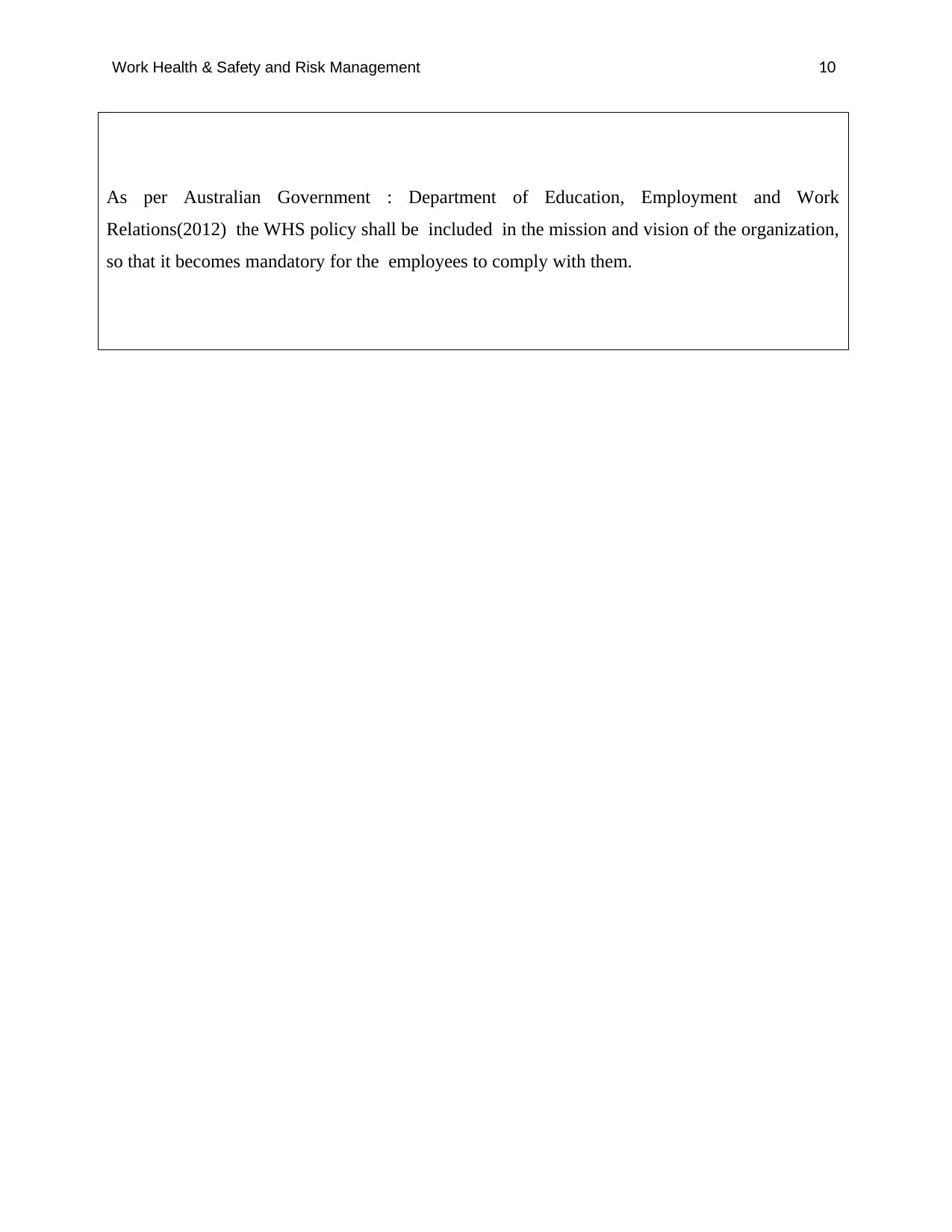
Work Health & Safety and Risk Management 10
As per Australian Government : Department of Education, Employment and Work
Relations(2012) the WHS policy shall be included in the mission and vision of the organization,
so that it becomes mandatory for the employees to comply with them.
As per Australian Government : Department of Education, Employment and Work
Relations(2012) the WHS policy shall be included in the mission and vision of the organization,
so that it becomes mandatory for the employees to comply with them.
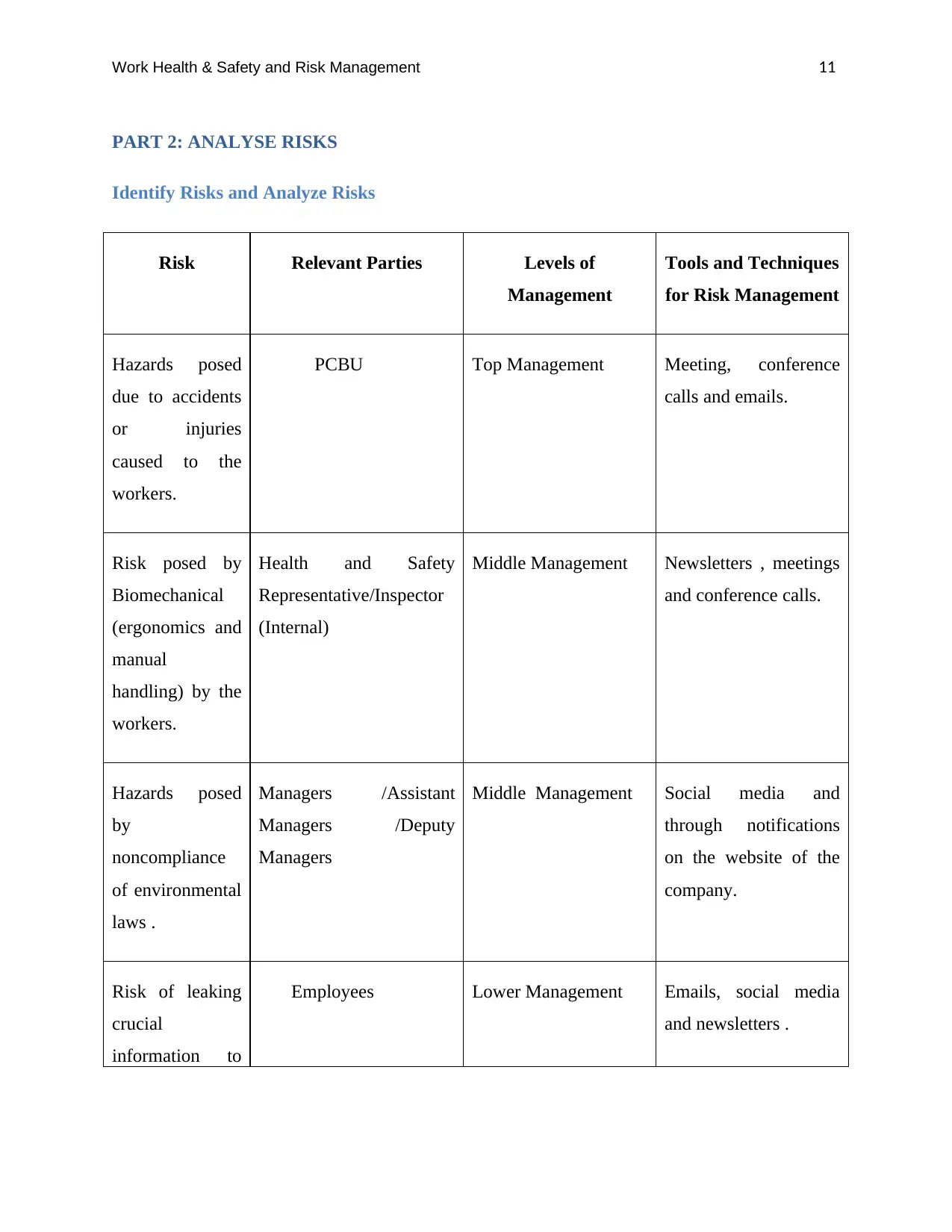
Work Health & Safety and Risk Management 11
PART 2: ANALYSE RISKS
Identify Risks and Analyze Risks
Risk Relevant Parties Levels of
Management
Tools and Techniques
for Risk Management
Hazards posed
due to accidents
or injuries
caused to the
workers.
PCBU Top Management Meeting, conference
calls and emails.
Risk posed by
Biomechanical
(ergonomics and
manual
handling) by the
workers.
Health and Safety
Representative/Inspector
(Internal)
Middle Management Newsletters , meetings
and conference calls.
Hazards posed
by
noncompliance
of environmental
laws .
Managers /Assistant
Managers /Deputy
Managers
Middle Management Social media and
through notifications
on the website of the
company.
Risk of leaking
crucial
information to
Employees Lower Management Emails, social media
and newsletters .
PART 2: ANALYSE RISKS
Identify Risks and Analyze Risks
Risk Relevant Parties Levels of
Management
Tools and Techniques
for Risk Management
Hazards posed
due to accidents
or injuries
caused to the
workers.
PCBU Top Management Meeting, conference
calls and emails.
Risk posed by
Biomechanical
(ergonomics and
manual
handling) by the
workers.
Health and Safety
Representative/Inspector
(Internal)
Middle Management Newsletters , meetings
and conference calls.
Hazards posed
by
noncompliance
of environmental
laws .
Managers /Assistant
Managers /Deputy
Managers
Middle Management Social media and
through notifications
on the website of the
company.
Risk of leaking
crucial
information to
Employees Lower Management Emails, social media
and newsletters .
⊘ This is a preview!⊘
Do you want full access?
Subscribe today to unlock all pages.

Trusted by 1+ million students worldwide
1 out of 19
Related Documents
Your All-in-One AI-Powered Toolkit for Academic Success.
+13062052269
info@desklib.com
Available 24*7 on WhatsApp / Email
![[object Object]](/_next/static/media/star-bottom.7253800d.svg)
Unlock your academic potential
Copyright © 2020–2025 A2Z Services. All Rights Reserved. Developed and managed by ZUCOL.




